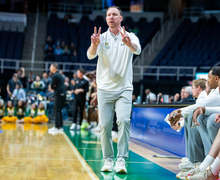Bluetooth app tracks class attendance at SU
Talia Trackim | Presentation Director
SpotterEDU is now used at about 40 colleges and universities.
Professor Jeff Rubin explained to the students in his IST 195 lecture how the SpotterEDU app would allow him to take attendance through the students’ phones.
“It’s called Bluetooth low energy,” said Molly Scheuer, a freshman who took Rubin’s class last semester. “Your phone connects to beacons on the walls of the classroom and it verifies that you’re close enough to connect.”
SpotterEDU, which students download on their phones and activate with a class code, uses Bluetooth to precisely determine when a student enters a room and to notify professors of absent students. The app is one of several ways SU can track its students through technology.
The app has made taking attendance for large classes like IST 195 — which has over 300 students — much easier, Rubin said. An earlier version of the app allowed students to send professors their exact location via a button. This function has since been removed, he said.
Rubin offers his students the opportunity to opt out of using spotter, although this requires them to see him at the end of class to confirm their attendance, he said.
SU initially partnered with SpotterEDU in 2016 to keep track of student-athlete attendance, said Rick Carter, CEO and co-founder of SpotterEDU. In its current form, the app has no means of providing student location data outside of a beacon-equipped classroom, he said.
“The original problem we were trying to solve was getting real-time information to coaches and advisors to assist in getting student-athletes to class,” said Carter, a former division-one basketball coach. “We were just automating this process.”
SpotterEDU has since ended its partnership with SU Athletics. Only a handful of SU professors, including Rubin, now use the app for academic purposes, Carter said.
While SpotterEDU’s hardware limits its reach to the walls of Rubin’s classroom, SU has other means of collecting student data, Rubin said.
Any IT resources that SU provides to students — such as free campus Wi-Fi or Office 365 — can collect student data, according to university policies. SU’s policy for student privacy rights protects against unreasonable search and seizure but does not mention data collecting or tracking.
Campus Wi-Fi in particular could allow SU to determine where a student is anywhere on campus at a given time, Rubin said.
“At any given moment, you could look at a device ID and figure out which access point that device ID is connected to,” Rubin said. “You’re hitting off an access point and that access point knows you’re there. So, yes, that data would be there.”
Data the university can collect from students’ phones through campus Wi-Fi is detailed in ITS’ acceptable use policy, said Eric Ferguson, communications director for SU’s Information Technology Services.
The university may access, copy or view data stored or transmitted on any IT resource SU provides under certain circumstances, according to the policy. Circumstances include complying with law enforcement, aiding in the university’s legal defense and protecting the health or safety of individuals.
The policy also permits the use of data transmitted or stored on IT resources when needed to perform necessary functions to further “the university’s mission and operations.” The website describes this type of data usage as a “last resort,” but does not provide specific examples.
The information accessible from students’ phones through campus Wi-Fi is similar to the data gathered by any other public Wi-Fi network, Rubin said.
“It’s a question of how you are utilizing that data,” Rubin said. “Technically the data’s there. But we implemented Wi-Fi not to track students — we implemented Wi-Fi to give students access to information.”
Ferguson did not respond to a request for comment seeking to clarify whether the acceptable use policy extends to location data on student mobile devices or messages sent through university email accounts.
Carter and Rubin both defended the use of SpotterEDU and similar services in tracking student attendance. Every athletic program that used the app has achieved an all-time high GPA average in the app’s first two years of use, Carter said.
Rubin described similar success boosting attendance in his classes.
“I’ve got enough data to show attendance has a direct correlation to your grade,” Rubin said. “It is because I care about the student and want them to do well in the class — not because of any data collection or surveillance.”
SpotterEDU now works with about 40 schools, including Ivy League schools such as Columbia University. The company in 2019 logged an upwards of 1.5 million student check-ins, Carter said in a Washington Post article.
As universities continue to implement new methods of compiling and analyzing student data, students like Scheuer have begun to accept the trade-off between privacy and convenience.
“I truly don’t care if an app is tracking me,” Scheuer said. “I don’t think that we have any privacy in the digital world anymore, if I’m being frank.”
Published on January 27, 2020 at 9:28 pm
Contact Sarah: scalessa@syr.edu | @sarahalessan





